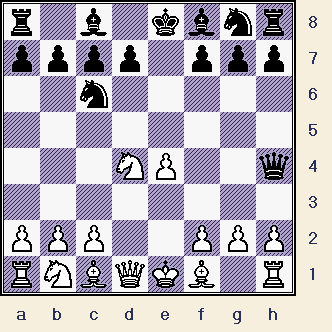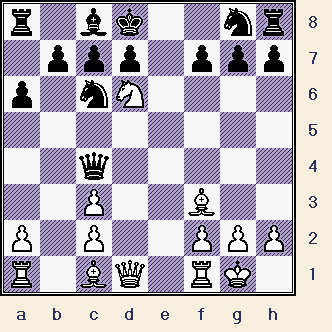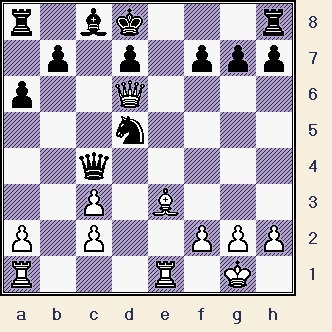All
the |
(Navigation bar
directly below.)
*******
© A.J. Goldsby, 2015.
(All rights reserved.)
****************
Click HERE
to see my
Chess Items.
****************
****************
Buy a book
from Amazon.com
(And help me out as well!)
****************
Click HERE
...
to see a list of the businesses that help to sponsor all of
my chess efforts.
Interesting games ... en passant |
This is primarily a text-based game ... to follow all of the analysis ... you will probably require a chess board.
Click HERE to see an explanation of the symbols that I use when annotating a chess game.
Click HERE to replay this game on a java-script replay board ... on a web page ... on another server.
T. Oral (2531) -
M. Kantorik (2289)
|
|
|
I saw this little encounter on another server, and I decided {for various reasons} to try and quickly analyze it. (Many opening reference works are at complete odds as to what is the best line of play; at least in many of the variations that I examined. I also could not be sure of the soundness of White's sacrifice on his 11th move, and therefore decided to subject that position to a fairly decent review.)
1.e4 e5;
2.Nf3 Nc6; 3.d4,
This old opening ... used to be a complete dinosaur. When I was coming up in chess, (the 1970's); many years could go by without a single decent game (in this opening) being published in the Informant.
... "The Scotch, 3.d4. Once a theoretical backwater, it has been revitalized by Kasparov's success with it." - GM John Nunn (NCO, page # 285)
I have about a dozen books and pamphlets on this opening system. (Two, off the top of my head, are by P. Wells and IM Gary Lane's, "Winning With The Scotch.")
[ Of course 3.Bb5, leads to a Ruy Lopez. ]
3...exd4;
4.Nxd4 Qh4!?; (Why?) {See the diagram given ... just below.}
This weird-looking sortie ... which appears to be the product of a rank beginner, is actually the deeply thought out concept of W. Steinitz. (I have several books on this one branch of this opening system.)
*********************************************************
|
|
*********************************************************
r1b1kbnr/pppp1ppp/2n5/8/3NP2q/8/PPP2PPP/RNBQKB1R w
See the volume:
< "4...Qh4 in The Scotch,"
by IGM Lev Gutman. >
Copyright (c) 2001.
Published by B.T. Batsford, Ltd. ISBN: # 0-7134-8607-4
Black actually gets a lot of pressure against White's e-Pawn, playing either side {today} requires a lot of deep preparation and homework.
[ The continuation of:
(>/=)
4...Bc5; 5.Be3 Qf6;
6.c3 Nge7; 7.Bc4 Ne5;
8.Be2 Qg6; 9.0-0 d6; 10.f3,
"+/=" {Diagram?}
probably yields White a tiny edge. [MCO-14, col. # 13; pg. # 107.]
The highest-rated encounter, (that I could find in any
database); was:
GM Sergei Rublevsky
(2645) - GM Kiril Georgiev
(2666);
21st EU-Cup / Saint Vincent
(R4), /
18,09,2005.
{This game was eventually drawn.}
Another respected reference work has 10-15 pages of analysis on
this opening. [See MCO-14, beginning on page # 101.]
]
5.Nc3,
(hmmm) Probably -
"+/="
Simple development. (Normally, this is never wrong, however in tricky gambit lines a lot of the normal rules ... "go out the window," as IM Gary Lane states in his book.)
[ Also popular for White is:
5.Nb5!?, ('!')
5...Bb4+!?;
According to MCO-14,
(page # 110, note
(k.)):
"Steinitz's 5...QxP/e4+!? isn't played much nowadays as White gains
definite compensation for the Pawn." (He goes on to quote a line
and a game, and says that pawn-grabbers could still experiment with it.)
*** *** *** *** *** *** *** *** *** *** *** *** *** *** *** *** *** *** *** *** *** *** *** *** ***
( Black has also tried the tricky:
5...Qxe4+!?; ('?!')
6.Be3!? Qe5!;
7.Qe2!? Kd8!?; 8.N1c3 a6;
9.Nxc7 Qxc7; 10.Nd5 Qa5+; 11.c3, "~"
with rather unclear play.
S. Arkell - Hugue / ENG, 1989.
[ See MCO-14, page # 109; column # 21, & also note # (o.). ]
*** *** ***
For the continuation of: (</=) 5...Bc5;
6.Qe2! Bb6!?; 7.Be3, "+/="
see MCO-14, pg. # 109, & col. 22. )
*** *** *** *** *** *** *** *** *** *** *** *** *** *** *** *** *** *** *** *** *** *** *** *** ***
6.Bd2 Qxe4+; 7.Be2 Kd8!?;
8.0-0 Bxd2; 9.Nxd2 Qf4;
10.g3 Qh6;
11.Nc4,
"~" 11...Nge7;
"~"
The author of MCO, who is a {former} U.S. Champ, considers this
position as (being)
equal. {Maybe a slight edge for White?}
IM G.S. Botterill - M. Staples; / Manchester, ENG; 1974.
(See also the encounter: J. Johannes - J. Ryska
/ [C45]
E-4-031 corr CiF corr / 27,02,2001.
White won this - second quoted - game in just thirty-three total
moves.)
[ See MCO-14, page # 109; column # 21 & all applicable notes. ] ]
5...Bb4;
6.Be2 Qxe4!?; ('?!')
While this capture appears to be rather risky ... an old (Chess Digest?) pamphlet actually awards this move an exclamation mark. (Personally, I don't like it. Black loses a lot of
time, place his Queen in peril and also aids White by opening lines.)
[ Probably more prudent was:
>/= 6...Nge7; ('!')
7.0-0 Bxc3;
8.bxc3 a6;
"~" {Diag?}
with a fair position for Black.
Wim H. Pommerel
(2362) - John D. Rhodes
(2331) / [C45]
EM/CL/Q06-3 email
/ ICCF Correspondence
/ 06,2002.
{Black won a convincing victory in just 45 overall moves.}
]
Now White gains the upper hand, in a quick and demonstrative manner.
7.Ndb5! Bxc3+;
(Forced?)
This is probably best, the alternatives look to be much worse for Black.
(See the variation given just below.)
[ Decidedly inferior was:
</= 7...Kd8?!;
8.0-0! Bxc3;
Probably best.
( </= 8...Qe6?; 9.Bg4 Qg6;
10.Bh5 Qf5; 11.Nd5 Ba5!?;
12.Bf4 d6!?; 13.Bxd6!, "+/-" )
9.Nxc3 Qd4;
10.Bd3,
"/\" '±'
and White continues to develop while gaining tempi on
the Black Queen. ]
8.bxc3
Kd8[];
This appears to be forced.
[ But not
</= 8...Qe5??;
as 9.f4,
{Diagram?}
wins for White ("+/-") ...
as Black cannot continue
to protect the
c7-square, (without dropping the Q). ]
9.0-0 a6?!;
(Maybe just - '?')
Fritz prefers >/= 9...d6 here.
10.Bf3,
Good enough for a substantial plus.
[ Maybe slightly better was:
(>/=) 10.Nd4! Nge7;
11.Re1,
"--->" ('±')
with a great game for White. ]
10...Qc4;
11.Nd6!?, (speculative?) {See the diagram given ... just below.}
I could not make up my mind if this was a great move ('!!') or just an unsound sacrifice. ('?!')
[Therefore this piece of work and web page.]
*********************************************************
|
|
*********************************************************
I subjected this position to several different analysis engines. (Fritz 8.0, Shredder 9.0, ChessMaster 10th Ed.) The result of all of this work was that this sacrifice was probably unsound. {But to be honest, even after many hours of work, I am
not 100% sure.}
[
>/=
11.Nd4 Nf6; 12.Re1!?,
"~" ("comp")
]
11...cxd6 ; 12.Qxd6 Nf6?;
('??')
[ Probably best
was: >/=
12...Nce7!;
13.Be3! Ke8!?;
14.Rfe1!,
"--->"
13.Be3 Ne7!?;
(Probably - '?!')
[ Black loses after the continuation of:
(Or 15...Qc4; 16.Bb6+ Nc7; 17.Rfe1 Re8; 18.Qd6!, "+/-")
16.Bb6+ Nc7; 17.Rfe1 Qf6;
18.Bxc6! dxc6[];
19.Bd4 Qg5!?;
(hmmm)
20.Qd6+ Bd7; 21.Bb6 Rc8;
22.Rbd1, ("+/-")
{Diagram?}
*********************************************************************************************
Of no real help was:
13...Ne4!?; 14.Bxe4 Qe6;
(</= 14...Qxe4?; 15.Bb6+ Ke8; 16.Rfe1, "+/-" wins the
BQ.)
15.Qg3! Ne5; 16.Rad1 Re8;
17.Bc5, ("+/-")
{Diagram?}
14.Rfe1 Nfd5!?;
[ Also useless was: 14...Nfg8;
15.Bc5 Qxc3; 16.Rab1,
"+/-" winning. ]
Now White has a surprising way to win.
r1bk2nr/1ppp1ppp/p1nN4/8/2q5/2P2B2/P1P2PPP/R1BQ1RK1 b
The losing move.
but White has a lot of pressure and an attack ... that will not really go
away anytime soon. ]
Black {now} seems to be lost ... no matter which continuation he chooses ...
(but this line may not be of any real help).
(>/=) 13...Qb5; 14.Rab1 Ne8;
15.Qa3 Qe5!?;
This sort of looks counter-productive, (staying in the open e-file); however
other lines were not much better.
This is almost certainly forced, taking with the Queen is met by 19.Qe7 mate.
This looks bad, but Fritz's move of 19...Qe6; should be met with 20.RxQ/e6,
followed by Black's resignation, (IMO).
and Black cannot defend both his e7-square and the Bishop on d7.
(Mate soon follows.)
This is probably forced. ('[]')
White has a dominating position. ("+ 3.28" according to Fritz 8.0)
]
This loses ... but so does everything else for Black.
*********************************************************
|
|
*********************************************************
r1bk3r/1p1p1ppp/p2Q4/3n4/2q5/2P1B3/P1P2PPP/R3R1K1 w
16.Qxd5!,
"+/-" (Black Resigns.)
White is winning easily.
Of course if Black takes the Queen, White simply responds with 17.Bb6#.
[ Black's game is completely lost.
At first, I thought that Black was premature in quitting.
-----> But then I
examined the following lines:
16.Qxd5! Qc7; Black cannot continue to allow his Queen to hang!
( </= 16...Qc6?; 17.Qxc6! dxc6; 18.Bb6+ Kd7; 19.Rad1#.)
17.Bc5!! d6[]; Probably forced.
( </= 17...b6?; 18.Qg5+!, & mates.)
18.Bxd6 Be6; ('[]') Fritz and Shredder agree that this one is forced.
( </= 18...Qd7?; 19.Qa5+!, w / mate in 2. )
19.Qg5+!, "+/-"
{Diagram?}
and no matter how Black replies, White wins the Queen for just
a
mere Bishop. ]
An interesting game ... from many different aspects. The opening is one of the more strange lines that either side can play ... and is certainly off the beaten path. And White's sacrifice ... while interesting, may not be completely sound.
Copyright (c) A.J. Goldsby, 2006. All rights reserved.
1 - 0
The analysis for this page was prepared with the excellent program, ChessBase 9.0.
The HTML was polished with several different tools and programs, (mostly FP) ... the text was checked for spelling with MS Word.
The diagrams were created with the program, Chess Captor 2.25.
|
Go ... or return ... to my Home Page for this site. Go (or return) ... to my "Annotated Games" (II) Page. Go
... or return ... to my "Best Games" Page. *******
Copyright (c)
LM A.J. Goldsby
I ******* This page was first generated in: mid-January, 2006. (Posted the same day, 01/16/2006.) This game was last edited, altered or saved on: July 14, 2012 02:16 AM . |


